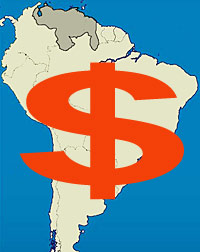
According to preliminary reports released by the Economic Commission for Latin America and the Caribbean (ECLAC), Venezuela registered the largest level of economic growth in Latin America, from a negative balance of 9.7% in 2003 to a positive balance of 18% in 2004. The economy of Latin America and the Caribbean also exceeded expectations with an average regional growth of 5.5%, a figure that surpasses world average growth of 4%.
“Oil -rich Venezuela’s economy will expand at almost 20% - the kind of growth matched only by booming Asian economies,” says the ECLAC report.
The Inter-American Development Bank (IADB) stated that regional exports reached $445.1 billion for the year, a growth of over 20% in comparison with 2003. The Washington-based organization attributes this growth to the US economic expansion and notes that strong recovery in countries such as Venezuela, Uruguay and Argentina boosted the region’s performance.
Latin America is recovering from its “Lost Decade”
This year marks the best regional economic performance since the debt crisis in 1982 and only the second time since 1980 that the six largest Latin American economies (Venezuela, Uruguay, Argentina, Brazil, Chile and Colombia) simultaneously experienced a growth rate of over 3%.
The most distinguished countries in the region are Venezuela (18%), Uruguay, whose growth reached 12%, and Argentina, which closes the year with an 8.2% growth rate. Prospects are also good for Panama (6%); Chile (5.8%); and Brazil (5.2%).
ECLAC’s report, “Preliminary Assessment of the Latin American and Caribbean Economies of 2004” cites the strong demand for agriculture and mining products from China and the United States as the catalyst for this growth. In particular, Latin American exports to China increased by 34% or $14 billion.
“The United States and China and the motors of this expansion, which highlights the increase of prices of basic goods that benefited several countries, in particular, South America, but hurt economies with deficits in Central America and in the Caribbean,” stated the report.
ECLAC also points out that the increase in prices for petroleum, crude oil and metals raised prices and were key in boosting growth, especially in the oil-exporting nations of Venezuela and Mexico.
With the exception of Haiti, noted executive secretary of CEPAL, José Luis Machinea, every country in the region registered positive growth rates.
Growth Rates vs. Reality
In spite of this economic recovery, Latin America remains the most unequal region in the world, with 224 million, or 43% of its population living in poverty. According to a report released by StatInfo, a consulting firm, “While the growth rates are very encouraging, they hide the underlying social tensions that are still putting pressures on the governments to relieve the unemployment rate and also provide more benefits for the lower-income portion of the population.”
Expectations for the future
According to the Minister of Economic Affairs from the Venezuelan Embassy in the United States, José Soto, the growth perspective for Venezuela over the course of the next three years will be between 5 and 7%, the highest in the region.
The Economic Commission for Latin America predicts an average growth rate of 4% for the region in 2005, warning that “Doubts about the strength of the US recovery and overheating of the Chinese economy do however pose risks for 2005.”
Growth 2004
– Venezuela: 18%
– Uruguay: 12%
– Argentina: 8,2%
– Ecuador: 6,3%
– Panamá: 6%
– Chile: 5,8%
– Brasil: 5,2%
– Perú: 4,6%
– Honduras: 4,3%
– Costa Rica: 4,1%
– México: 4,1%
– Nicaragua: 4%
– Bolivia: 3,8%
– Colombia: 3,3%
– Cuba: 3%
– Paraguay: 2,8%
– Guatemala: 2,6%
– El Salvador: 1,8%
– Dominican Republic: 1,8%
– Haití: -3%
– Average: 5,5%
Source: Economic Commission for Latin America and the Caribbean (ECLAC)
 Articles by this author
Articles by this author











Stay In Touch
Follow us on social networks
Subscribe to weekly newsletter